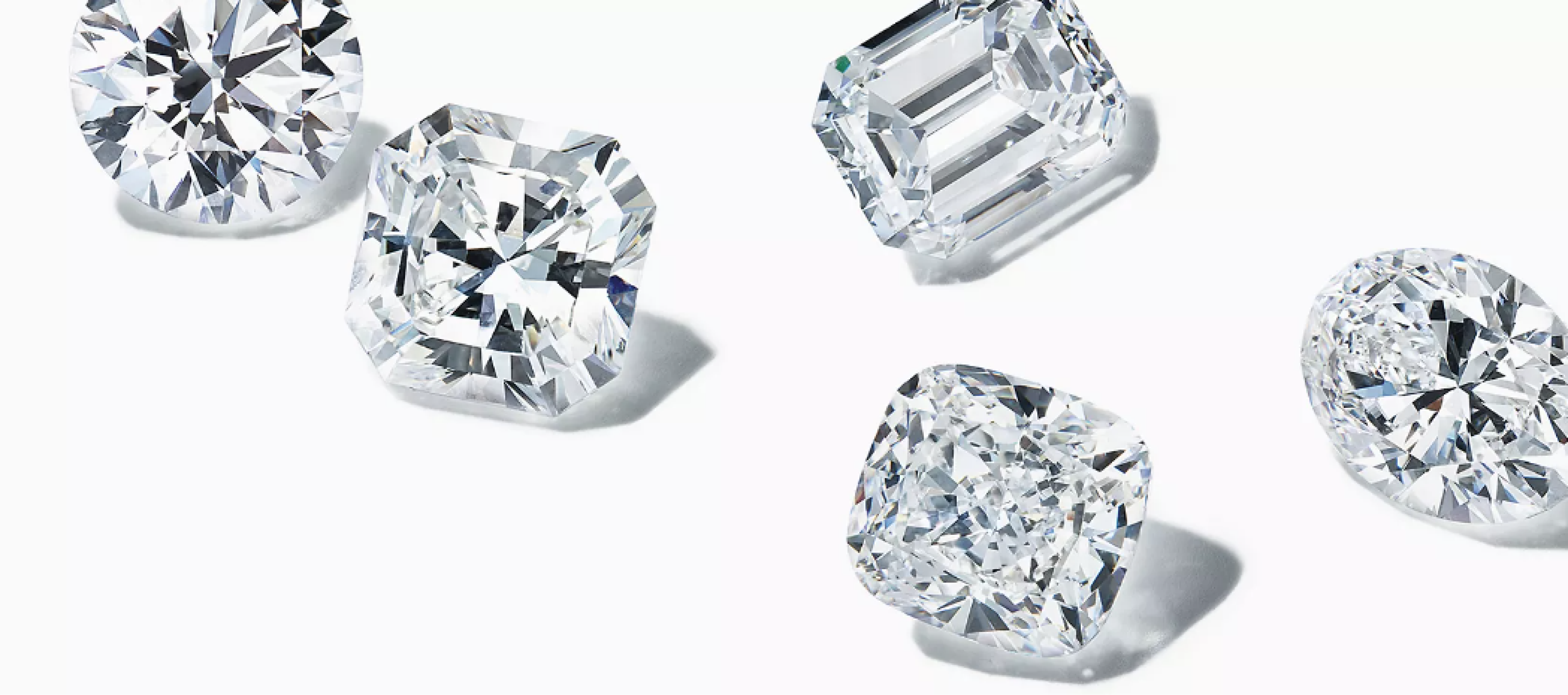Asscher: Named for the Asscher brothers of Holland, who
first manufactured this unique cut more than a century ago, the
Asscher cut is a square shape with delicately arranged facets.
The cut offers both beauty and sophistication, with greater
brilliance and shine than the similar emerald cut.
Baguette: Deriving its name from its elongated,
rectangular shape, like the French bread for which it is named,
baguettes work as both a focal stone and as a secondary stone.
With its pristine parallel lines and exceptional clarity, a
baguette cut diamond makes for an exquisite side stone that
complements and enhances the focal stone.
Bullet: A baguette cut with one pointed end resembling a
bullet, this cut is often used as a side stone in engagement
rings. They make a great complement to Asscher, emerald, and
brilliant cut center diamonds.
Cadillac: Like the elongated shield emblem of the
renowned auto brand, the Cadillac cut is five-sided with a
single long side serving as the base, two sides tapering away
from the base, and two sides tapering back together at the top
to form an apex. This cut works beautifully as a matched pair or
as accent stones.
Cushion: This consumer favorite is like a marriage of the
square shape of a princess and the softness of a round
brilliant, rounding the corners of the square to resemble a
pillow. The result is a complex surface that offers exceptional
fire. We offer this best-selling cut in an assortment of
configurations, so your customers can have something that is
both highly popular and highly personalized.
Emerald: This cut, as the name suggests, was originally
used to cut emeralds, and is available in both square and
rectangular shapes. The emerald cut is sleek and elegant,
characterized by a substantial table surface area and uniform
profile. One of the most popular choices for engagement rings,
an emerald cut diamond will satisfy even the most sophisticated
customers.
Epaulet: Named for the shoulder adornments on military
uniforms, the epaulet is a modified five-sided fancy cut diamond
with a shape halfway between a tapered bullet and a trapezoid.
Similar to the Cadillac diamond epaulets complement both long
and short center stones and are available in step cut and
brilliant cut styles.
Half Moon: This half-circle or half-oval shape is
typically used as a side stone. Half-moon cuts complement
rectangular center stones like princess, radiant, and emerald
cut diamonds, bringing a touch of softness and sense of
lengthening to any center stone.
Heart: This cut requires significant skill to craft, but
is well worth it because a heart-shaped diamond is the perfect
symbol of enduring love. Inspired by the pear cut with a
modified brilliant diamond shape, the heart silhouette offers
exceptional shine. A heart cut diamond can be more broad or more
narrow by varying the diamond’s length-to-width ratio, allowing
you to offer your customers a more unique diamond purchase and
the ability to adapt to a wider range of setting styles.
Kite: Shaped like the classic flying toy, this cut has an
art-deco vibe and is typically used as a side stone to
complement a round or rectangle stone. But don’t hesitate to
offer it as the main act, because it performs beautifully solo
as well.
Marquise: For those who love a vintage look, there is the
marquise cut, which originated in 18th century France. You may
also have heard of it referred to as a “navette” or
“boat-shaped” diamond. The elongated, narrow shape maximizes
brilliance, adding glamor to any setting. It is often set with
prongs but can also be bezel set to minimize snagging on fabric.
Oval: The elongated silhouette of an oval cut diamond
makes it look larger than other cuts of the same carat weight.
Stylish and sophisticated, oval cuts radiate fire and brilliance
comparable to round cut diamonds.
Princess: Second in popularity only to the round cut,
princess cut diamonds offer an exquisite and timeless shape that
complements both traditional and contemporary aesthetics. Its
geometric design, a square shape with an inverted pyramid
profile, boasts a brilliance nearly equivalent to that of a
round diamond.
Radiant: Radiant cut diamonds feature an emerald shape
with a faceted crown and pavilion like a brilliant cut. Like a
stunning slab of ice under the low winter sun, radiant cut
diamonds typically have small color variations across the cuts
and reflect light in a dazzling display of fire nearly as bright
as a round diamond.
Round: The most popular cut of diamond, and with good
reason, the round cut was designed to maximize the diamond’s
dazzling optical properties. Its geometrical design and
symmetrical structure allow the greatest volume of light to
emanate from its complex array of facets. This shape is always
in demand and is a favorite for engagement rings, necklaces, and
other elegant jewelry.
Tapered Baguette: Also known simply as a “taper,” the
tapered baguette is an elongated diamond cut narrower at one end
than the other, like a tall drinking glass. Aside from being the
most prevalent side stone in engagement rings, the tapered
baguette works well alongside rounds, ovals, and other
traditional shapes.
Trapezoid: Trapezoids are a common side stone shape that
work best with elongated or larger stones. Step cut trapezoids
are ideal companions to an Asscher or emerald cut center stone,
while brilliant cut trapezoids look … well, brilliant …
alongside a princess or radiant cut center stone.

